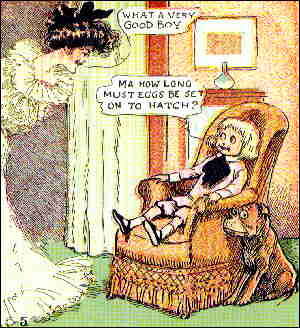
BUSTER BROWN
Medium: Newspaper ComicsOriginally Appearing in: The New York Herald
First Appeared: 1902
Creator: Richard F. Outcault
Please contribute to its necessary financial support.
Amazon.com or PayPal

|
BUSTER BROWNMedium: Newspaper ComicsOriginally Appearing in: The New York Herald First Appeared: 1902 Creator: Richard F. Outcault Please contribute to its necessary financial support. Amazon.com or PayPal |
| … at the 1904 World Fair but hardly anyone is aware of the character's comic strip origins.
Buster was as mischievous as The Katzenjammer Kids, and he was created by Richard Felton Outcault, the cartoonist behind The Yellow Kid. So why didn't he share in the infamy heaped by Polite Society on those two features? One theory is that he was invariably punished for his misdeeds — but that can't be it, because the Katzenjammers always got spanked in the end, too. Another is that he appeared in a more respectable journal than the others — but that can't be it either. Before the strip had been running four years, Outcault switched employers; and from then on, Buster ran in the Hearst papers. Perhaps it was because each of Buster's Sunday pages ended with a sweet homily in which the lovable tyke promised never again to do whatever it was that had gotten him into trouble — but are social critics, most of whom are parents themselves, dumb enough to fall for a ploy like that? Yet another theory has to do with the fact that Buster belonged to a well-to-do, WASPish family, unlike the declassé ethnics of those other strips. Perhaps that's why he raised less outcry from well-to-do, WASPish Americans. Whatever the reason, Buster was popular even in the more respectable portions of Society, from the day he first appeared in The New York Herald, May 4, 1902. So popular, he was first adapted into movies in the second year of his series, by director Edward Porter (Dreams of the Rarebit Fiend). Buster's constant companion was his dog, Tige, said to be the first talking pet in American comics. Like Gorgon of Barnaby and Hobbes of Calvin & Hobbes, Tige's speech was never observed by adults. He sometimes functioned as a half-hearted conscience for Buster, sometimes as a sentry, and sometimes as a Greek chorus, commenting on the action without directly taking part. When, in 1906, Buster switched newspapers, The Herald sued Hearst. As had been the case ten years earlier, when Outcault brought The Yellow Kid to Hearst, the court ruled that the characters could go with the cartoonist, but the name of the feature must stay with the publisher. From then on, Outcault produced his strip without using the character's name in the title, while the original strip continued at the Herald under a succession of less talented artists. Records are spotty, but the Herald version of Buster Brown seems to have lasted at least until 1911, and Outcault's version until 1921. During the late '20s, there was a series of Buster Brown silent comedy shorts, with child actor Arthur Trimble in the title role and Lois Hardwick (Alice) as his girlfriend. Eventually, Buster Brown as a character faded into the past, but the Buster Brown merchandising phenomenon continued — and, in fact, continues to this day. Outcault died in 1928, a wealthy man. — DDM BACK to Don Markstein's Toonopedia™ Home Page
|
|